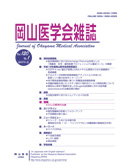

Journal of Okayama Medical Association
Published by Okayama Medical Association<Availability>
Full-text articles are available 3 years after publication.
Permalink : https://ousar.lib.okayama-u.ac.jp/17337
ヒト胎児肝細胞の培養 第2報
今井 寛途
岡山大学医学部付属癌源研究施設病理部
発行日
1978-06-30
抄録
In the previous report, we dealt with the method and the culture of human embryonic liver cells, and its difficulties in establishing epithelial cell lines from normal human liver. HuL-4 cell strain was published as an epithelial cell strain in the previous paper. We examined the cell morphologically, histochemically, and the cellular localisation of albumin and AFP (α-fetoprotein) immunofluorescently. Chromosome of the cells and uptake of Indian ink into the cell were also undertaken. We also calculated the growth curve of the strain and analyzed the liver specific enzymes. The results are summarized as follows. 1). HuL-4 cell strain derived from human embryonic liver disclosed dominant epithelial cell growth than fibroblastic cells, and it continued to cultivate up to 24 passages in 758 days. 2). Direct immunofluorescence method for albumin and AFP failed to show any positive stain. 3). PAS staining of the cell revealed weak positive, and it was digested by diastase. PAP silver staining was negative, and the uptake of Indian ink into the cells was negative for up to 12 hours. 4). Chromosome analysis of the cell was normal (46 numbers, diploid) and no marker chromosomes were detected. 5). Hul-4 cell strain was epithelial morphologically, but it contained no liver specific enzymes.
ISSN
0030-1558
NCID
AN00032489
